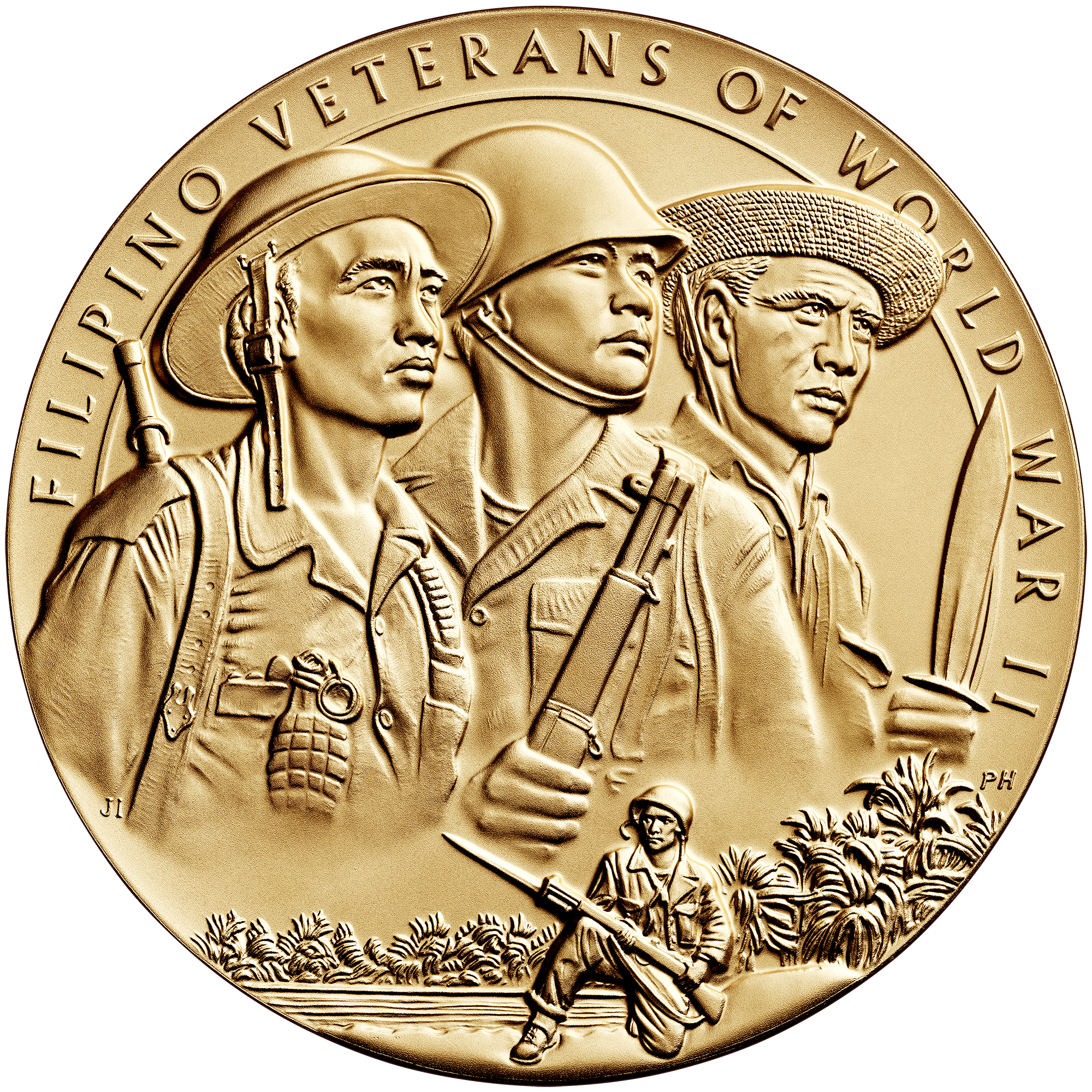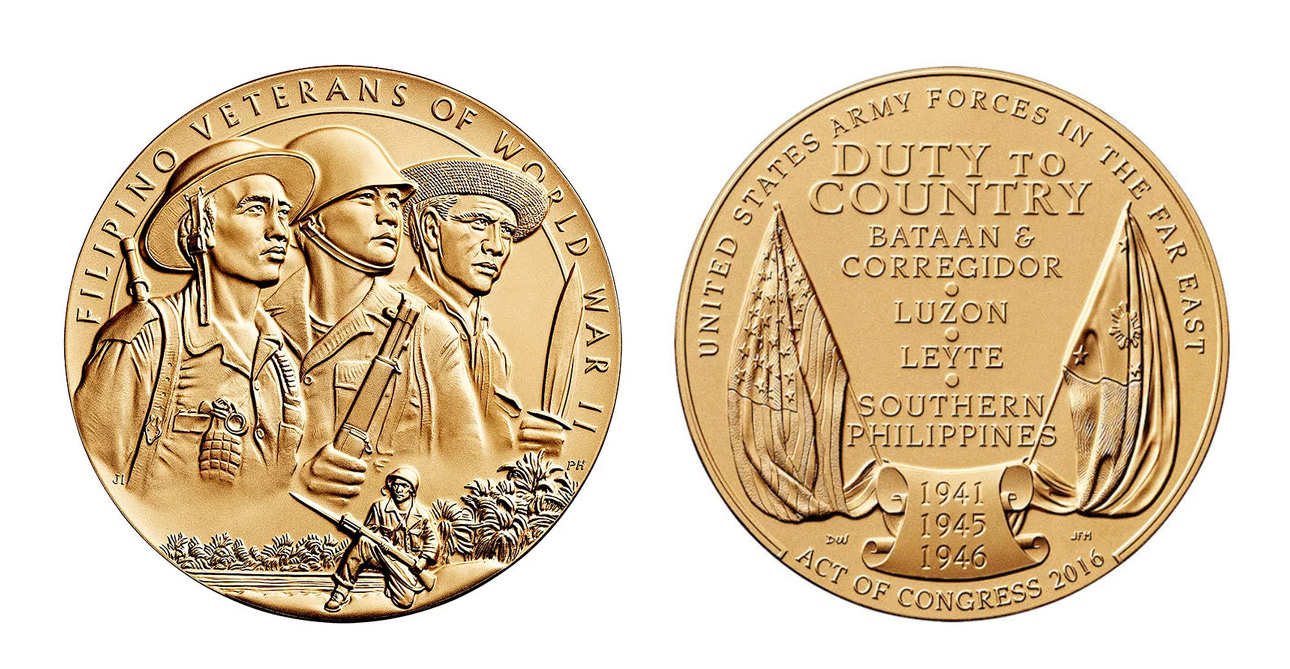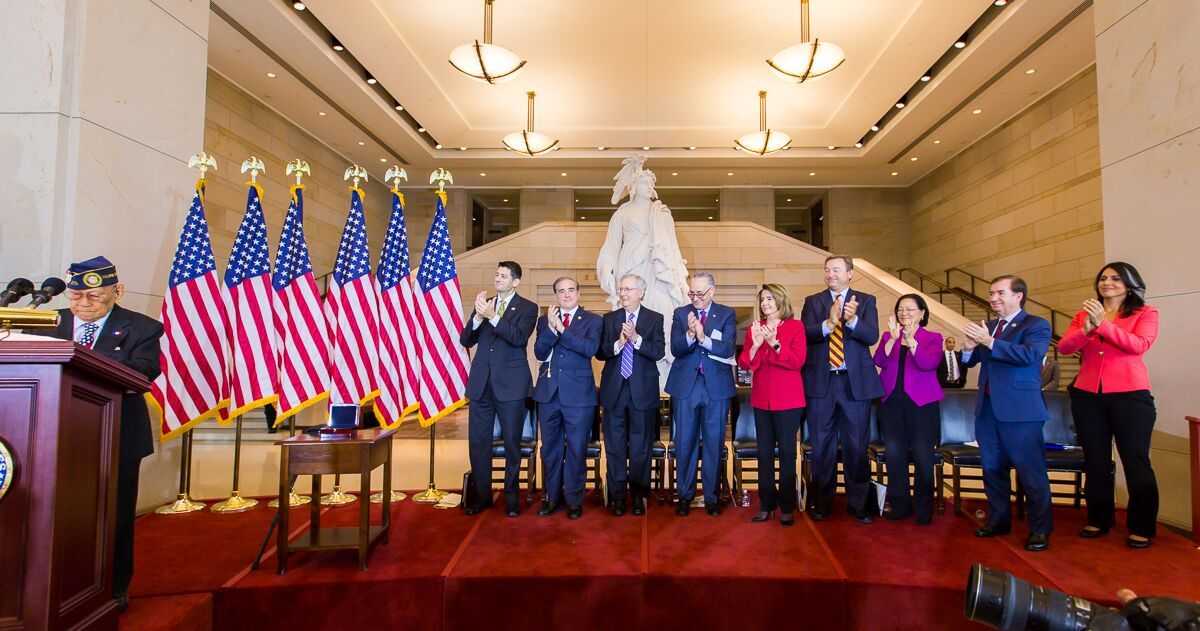Explainer 11:

The Congressional Gold Medal
Students learn about the meaning of the Congressional Gold Medal honoring Filipino veterans, including elements of its design and the first ceremony in Washington, D.C.
Teacher Background
In 2009, after more than 60 years of activism, Congress included Filipino veterans benefits in the 2009 American Recovery and Reinvestment Act. At long last, some material benefits were achieved for the relatively few remaining veterans still alive. The law provided a one-time lump sum payment to eligible surviving veterans in the U.S. or the Philippines; $14,000 for U.S. citizens and $9,000 for non-citizens. The law also recognized that service in USAFFE was, indeed, service “in” the U.S. armed forces. Though the process was arduous, more than 48,000 veterans filed claims before the 2010 deadline. About 18,000 were awarded–less than ten percent of the 200,000 Filipinos who had served.
But that was not the end of the story. From the beginning, the Filipino veterans movement was about both the restoration of material benefits as well as the less tangible but equally important goal of honoring veterans’ service and dignity. With the WWII generation passing away and some benefits finally restored, the activist movement identified new goals to recognize veterans. These included 1) increasing awareness of Filipino veterans’ story by ensuring it was taught in U.S. history classrooms; and 2) awarding Filipino veterans with the Congressional Gold Medal.
The Congressional Gold Medal (CGM) is the nation’s highest civilian honor bestowed by Congress. It was first awarded by George Washington in 1776. The CGM campaign, which kicked off in 2014, was not about winning citizenship rights or veterans benefits. It was about recognition. The medal would establish beyond a doubt something that many Americans denied or did not fully understand: the crucial role that Filipino servicemembers–without regard to race, nationality, or duty status–had played in the history of the United States. The Filipino Veterans Recognition and Education Project (FilVetRep) was formed to move these goals over the finish line.
Awarding the CGM requires an act of Congress. It requires two-thirds of the House (290) and Senate (67) to co-sponsor the bill. The medal itself is designed and produced by the U.S. Mint. The FilVetRep team selected the final designs from among 43 proposals.
Experienced activists were able to rally bipartisan support relatively quickly. Congress passed the law on November 30, 2016; in one of his last acts as president, Barack Obama signed it into law on December 14, 2016. The CGM was officially awarded on October 25, 2017, at a ceremony in the U.S. Capitol in Washington, D.C. Since then, more than 70 CGM ceremonies have been held around the U.S. and in the Philippines, recognizing more than 2,500 veterans or their survivors.
Suggested Teaching Strategies
- Use the focus questions to help students analyze the design of the medal and discuss its significance.
- More details about the design of the medal can be found here: https://filvetrep.org/congressional-gold-medal/
- Ask students to discuss why recognition is/was so important to Filipino veterans. What does recognition mean (in veterans’ own words, to students, to families of veterans, etc.)? Students can listen to veterans’ own reflections in the sections linked below.
- Have students explore the Congressional Gold Medal section of Under One Flag. There they can learn more about the key civilian and Congressional leaders involved in the bill, watch the first ceremony, and hear veterans talking about the meaning of receiving the medal.
- Students can dive into the eligibility requirements and see the application veterans or their next of kin must complete to receive the medal here: https://filvetrep.org/
- The full CGM ceremony on Oct. 25, 2017 can be viewed here: https://www.youtube.com/watch?v=N8XFn2cixCM
- Have students learn more about Celestino Almeda (pictured) by listening to his oral history excerpts and viewing animations based on his story in Under One Flag: https://dutytocountry.org/project/celestino-almeda/. After doing so, ask students why they think he was selected to give remarks at the first CGM ceremony.
- Have students research other recipients of the Congressional Gold Medal and consider the political and social dimensions of giving the award. How has the nature of recipients changed over time? How has the act of awarding the medal helped achieve the goal of “forming a more perfect union” over time?
- A full list of recipients can be found here: https://history.house.gov/Institution/Gold-Medal/Gold-Medal-Recipients/
- The public law awarding the Filipino veterans’ medal can be found here: https://www.govinfo.gov/content/pkg/PLAW-114publ265/pdf/PLAW-114publ265.pdf
- More information, including a video, about the crafting of CGMs can be found here: https://www.usmint.gov/learn/coin-and-medal-programs/medals
- Ask students to propose another individual or group who should be so honored, write a short rationale, and sketch a design.
Curriculum Standards
Common Core: Middle School
- CCSS.ELA-LITERACY.RH.6-8.1 Cite specific textual evidence to support analysis of primary and secondary sources.
Common Core: High School
- CCSS.ELA-LITERACY.RH.11-12.1 Cite specific textual evidence to support analysis of primary and secondary sources, connecting insights gained from specific details to an understanding of the text as a whole.
Selected Laws and Events Affecting Filipino Immigration to the United States
The Congressional Gold Medal is the nation’s highest civilian honor awarded by Congress. Filipino veterans rallied Congress to award the medal, with a bill signed into law on December 14, 2016. The first medals were presented to veterans—some over 100 years old!—and their survivors in a ceremony in the U.S. Capitol on October 25, 2017. To date, 2,500 veterans have been awarded the medal. Details of the design were carefully chosen to represent the story of Filipino veterans.


Celestino Almeda receives a standing ovation from congressional leaders during the first Congressional Gold Medal ceremony in October 2017. Others pictured include House Speaker Paul Ryan, Senate Minority Leader Mitch McConnell, Senate Majority Leader Chuck Shumer, House Minority Leader Nancy Pelosi, and sponsors Sen. Dean Heller, Sen. Mazie Hirono, Cong. Joe Heck and Cong. Tulsi Gabbard.
Focus Questions
- There are four Filipino soldiers on the obverse (heads) side of the medal. Who do the different figures represent? What details help you identify them?
- What do you notice about the poses of each soldier? What ideas do you think the artist wanted to convey about Filipino veterans, based on how they are depicted?
- What are the flags on the medal, and what do they represent?
- What is the significance of the places listed on the medal?
- What is the significance of the dates listed on the medal?
- Why do you think the phrase “Duty to Country” was included?
- If you could add something to the medal, what would it be and why?
- Do you think the Congressional Gold Medal is an appropriate way to honor veterans? Why or why not? What other ways can you think of to honor Filipino veterans?
- Why do you think the recognition provided by the Congressional Gold Medal was so important to Filipino veterans?
